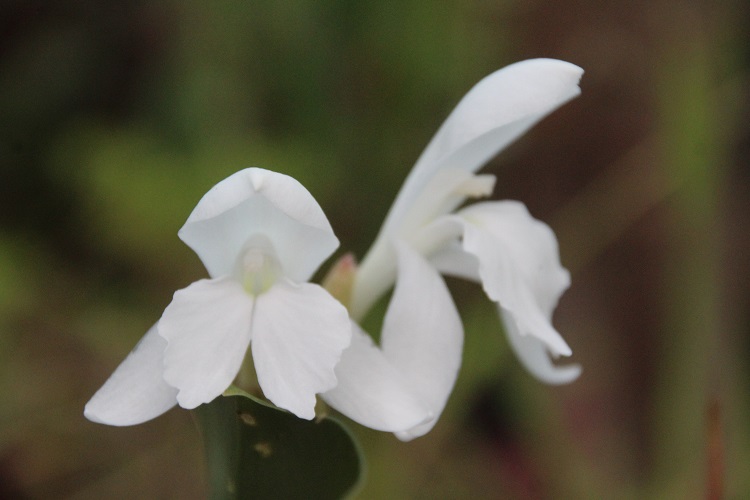Ian Young writes in his SRGC Bulb Log:
"Roscoea humeana alba is my favourite of all: the stunning white of the flowers has to be seen to be believed.
Notice how the petals go translucent when they are soaked in water - the short lived flowers do not hold up well in rain at all which is odd
for a plant that seems to require plenty water during growth - perhaps they are used to ground water."
In the Journal of the Alpine Garden Society for 2008, an uncredited author writes in the report of the Summer Show North, 2007:
"Roscoea humeana forms alba. A mid-altitude Chinese species from Yunnan and Sichuan with large, bold flowers on short stems,
elongating as the leaves develop. Ron McBeath at Lamberton Nursery, just north of Berwick, raises them from seed in all shades of purple, lilac
and pink, one or two per cent producing white flowers like the plant exhibited. It is equally at home in the open garden as it is when grown in a pot.
Roscoeas, relations of ginger, require ample moisture during the growing season."
In part.2 of the same volume Gary Dunlop says:
"(Ron McBeath) has also collected and introduced two pure white forms which are quite dwarf, one being much more floriferous than the other, which
is slightly later in flowering, by a matter of days. Both are regrettably very slow to increase vegetatively. Only a small proportion of plants
raised from seed flower true, most of the progeny being a pale lavender shade."
In 2008 R. humeana f. alba was awarded a Preliminary Commendation when exhibited at Wimborne show. Robert Rolfe writes:
"This relatively early-flowering, very decorative species is localy prolific in Yunnan and Sichuan, from where material was first brought back in the
late nineteenth and early twentieth centuries. For a long time only the purple-pink forms were generally grown, but in the lst 15-20 years
especially the range hs broadened, and the latter-day patron saint of the genus, Jill Cowley, has described several phases. Dark, almost blackish-purple
forms were recognised as forma tyria in 2000, soft yellow ones as f. lutea (in the same year, including in their synonymy
(Roscoea sichuanensis,) and in 2007 forma alba, delineating the white ones, joined the throng. The first two have already received awards
but abinos are much harder to source, partly because parent plants have only a 10-20% true-breeding rate, and partly because vegetative propagation
by means of division in midsummer is a slow business, with any spare plants avidly scooped-up by ever-vigilant collectors.
Almost all plants derive from two plants collected in 1987 by the Sino-British-Lijing Expedition, under the number SBLE.636, one with greenish
yellow tinge, the other more handsome and faintly pinkish with age on the reverse of the flowers. These were kept at RBG Edinburgh, where one of
the expedition's participants, Ron McBeath, worked as Assistant Curator. In 1998 he and his wife Susan set up Lamberton Nursery,
just outside Berwick-upon-Tweed; here stocks from the above source have been painstakingly worked up. These are grown under the shelter of a
polytunnel, in black plastic long toms, buried almost to their rims in a ground-level sand plunge. (This is important; leave them free-standing
and their contents will either 'cook' on a hot summer's day, or suffer the plant equivalent of hypothermia in the winter, as the writer has found to his
cost with a treasured offset. Panted out, the tubers often work their way down to a greater depth, and are further protected by a much greater
body of soil, making losses much less likely.)
Every so often a seedling comes good, inheriting the virginal purity of the vegatatively-propagated parent, and one of these was submitted for award.
This was not realised at the time, when the suggestion was made that a clonal name would be a suitable way of commemorating the introduction's 21st birthday.
But the plant shown, while representative of forma alba at its best, is a one-off, and as such it is best to leave matters with the Latin
qualifier, at least until a proven, free-multiplying example, or ese the better of the two SBLE progenitors comes before the Committee.
All that needs to be said at this stage is that although the flowers are fleeting (in very warm weather they last only a day or two),
and are produced successively and sometimes abundantly, as with another waxy-white ephemeral blooming around the same time,
the central American Weldenia candida, you simply remove the fallen, withered, long tubed blooms day by day, and enjoy a performance
that can last for a fortnight at least. The flowers are notable for their large, hooded, acuminate dorsal petal, or cowl (the Cowley nexus
hasn't escaped me) and their slightly ribbed, bifurcated, double tiered lip, with no hint of any colouration beyond the yellowish throat.
The smallish clump seen had three shoots, with the broad, deep green leaves semi-developed, and a total of 10 flowers in their prime: this is an audacious,
as-if-from-nowhere early summer performer that can be enjoyed as a pot plant, in a peaty raised bed, or in a slightly shaded, high-humus billet, where
it will perform reliably is kept free from competing vegetation."
|



